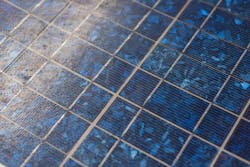A research team based out of the United States National Renewable Energy Laboratory, has developed a multi-junction solar cell that it says has broken an efficiency record. The research team partnered with the Swiss Center for Electronics and Microtechnology to create the so-called tandem solar cell, combining two layers of semiconductor material to absorb more of the solar spectrum.
In laboratory tests, the research team demonstrated that the solar cell could convert direct sunlight into electricity at 29.8% efficiency. David Young, a senior researcher at the NREL, points out that these results edged out the theoretical limit of 29.4% for mechanically stacked cells. In addition, the device works without having to concentrate sunlight with reflectors, which can increase efficiency in certain solar cells.
Each research center contributed part of the dual-junction solar cell, which combines III-V and crystalline silicon semiconductors. CSEM scientists developed a silicon sub-cell, on top of which NREL stacked a layer of gallium-indium phosphide. The resulting device has a higher efficiency than either material by itself. The record efficiency for an individual crystalline silicon cell is 25.6%, while the highest efficiency for single-junction GaInP cells is 20.8%.
“We believe that silicon heterojunction technology [that combines different crystalline semiconductors] is today the most efficient silicon technology for application in tandem solar cells,” says Christophe Ballif, head of photovoltaic research at CSEM.
The researchers gave few additional details in a recent news release, but Young has submitted the team’s research paper to the Journal of Photovoltaics for publication. The experimental results were published in the journal Progress in Photovoltaics in an article reviewing solar cell designs and the highest efficiency in each category.
The review, which includes solar cells up to three times more efficient than conventional solar panels, underlines the fact that efficiency is not everything for commercial solar cells. The highest efficiency ever recorded was 46% for a multi-junction device under highly concentrated sunlight. Soitec, a French company that makes photovoltaic semiconductors, engineered the solar cell in 2014. But the company has since stopped producing this technology.
Despite these higher efficiencies, multi-junction solar cells have been kept out of the commercial market by their complex structure and high manufacturing costs. These devices have typically been limited to satellites and other spacecraft. On the ground, they have to compete with the gradually falling cost of crystalline silicon, the most prevalent material for conventional solar cells. Mass-produced silicon cells are typically less than 20% efficient, but they are relatively cheap compared to the exotic material normally used in multi-junction cells.
The NREL, which is the primary research laboratory for the U.S. Energy Department, is examining several different semiconductor materials for solar cells. Last November, the laboratory found a way to significantly reduce the amount of energy lost to heat in perovskite-based solar cells. The discovery could one day lead to solar cells that convert up to two-thirds of sunlight to electricity.
The dual-junction research was funded in part by the Energy Department’s SunShot Initiative, a program aimed at making solar energy cost-competitive with fossil fuels. Additional funds were provided by the Swiss Confederation and Nano-Tera.ch, a Swiss green technology fund.
About the Author
James Morra
Senior Editor
James Morra is the senior editor for Electronic Design, covering the semiconductor industry and new technology trends, with a focus on power electronics and power management. He also reports on the business behind electrical engineering, including the electronics supply chain. He joined Electronic Design in 2015 and is based in Chicago, Illinois.

